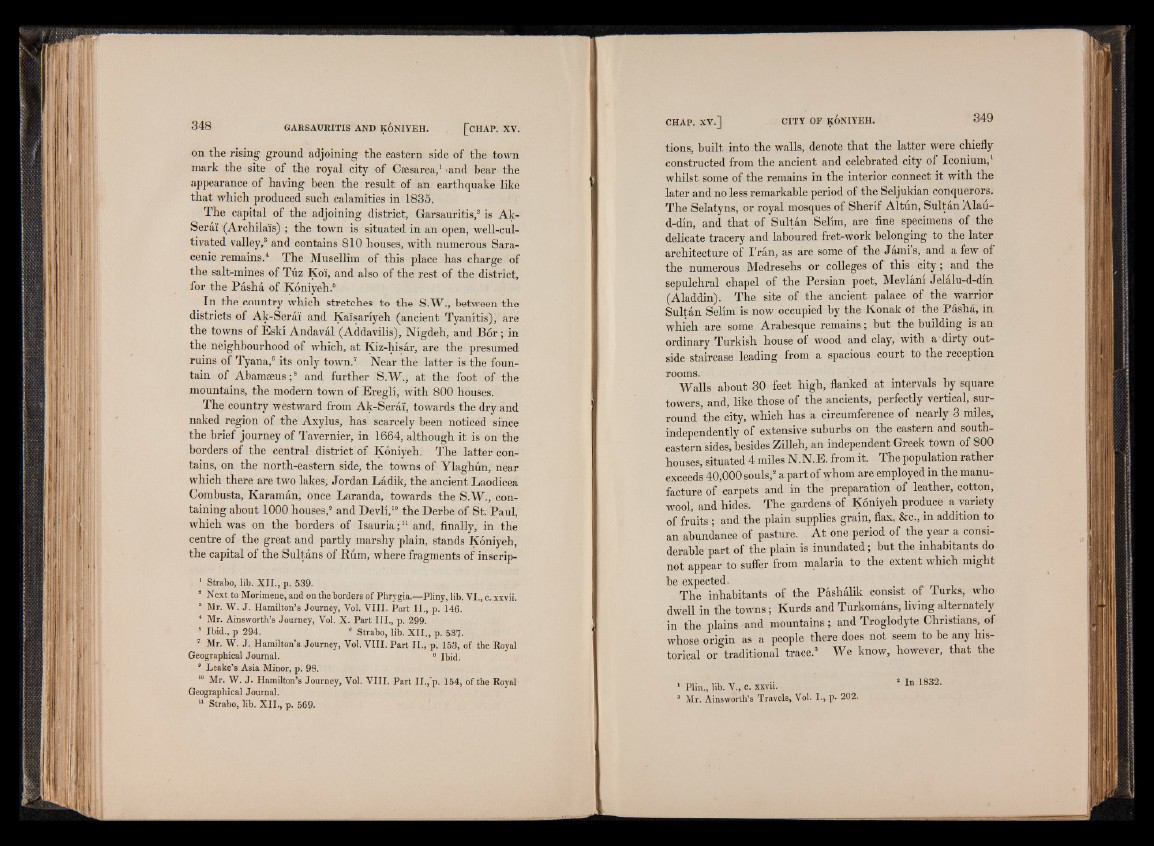
on the rising ground adjoining the eastern side of the town
mark the site of the royal city of Caesarea,1 /and bear the
appearance of having been the result of an earthquake like
that which produced such calamities in 1835.
The capital of the adjoining district, Garsauritis,2 is Ak-
Serai (Archila'is) ; the town is situated in an open, well-cultivated
valley,3 and contains 810 houses, with numerous Saracenic
remains.4 The Musellim of this place has charge of
the salt-mines of Tuz Koi, and also of the rest of the district,
for the Pasha of Koniyeh.5
In the country which stretches to the S.W., between the
districts of Ak-Serai and Kaisariyeh (ancient Tyanitis), are
the towns of Eski Andaval (Addavilis), Nigdeh, and Bor; in
the neighbourhood of which, at Kiz-hisar, are the presumed
ruins of Tyana,6 its only town.7 Near the latter is the fountain
of Abamseus;8 and further S.W., at the foot of the
mountains, the modern town of Eregli, with 800 houses.
The country westward from Ak-Serai, towards the dry and
naked region of the Axylus, has scarcely been noticed since
the brief journey of Tavernier, in 1664, although it is on the
borders of the central district of Koniyeh. The latter contains,
on the north-eastern side, the towns of Ylaghun, near
which there are two lakes, Jordan Ladik, the ancient Laodicea
Combusta, Karaman, once Laranda, towards the S.W., containing
about 1000 houses,9 and Devli,10 the Derbe of St. Paul,
which was on the borders of Isauria;11 and, finally, in the
centre of the great and partly marshy plain, stands Koniyeh,
the capital of the Sultans of Rum, where fragments of inscripI
Strabo, lib. X II., p. 539.
9 Next to Morimene, and on the borders of Phrygia.—Pliny, lib. VI., c. xxvii.
8 Mr. W. J . Hamilton’s Journey, Vol. VIII. Part II., p. 146.
4 Mr. Ainsworth’s Journey, Vol. X. Part III., p. 299.
s Ibid., p 294. 8 Strabo, lib. X II., p. 537.
7 Mr. W. J. Hamilton’s Journey, Vol. VIII. Part II., p. 153, of the Royal
Geographical Journal. 8 Ibid.
8 Leake’s Asia Minor, p. 98.
10 Mr. W. J. Hamilton’s Journey, Vol. VIII. Part II., p. 154, of the Royal
Geographical Journal.
II Strabo, lib. XII., p. 569.
tions, huilt into the walls, denote that the latter were chiefly
constructed from the ancient and celebrated city of Iconium,1
whilst some of the remains in the interior connect it with the
later and no less remarkable period of the Seljukian conquerors.
The Selatyns, or royal mosques of Shenf Altun, Sultan Alau-
d-din, and that of Sultan Selim, are fine specimens of the
delicate tracery and laboured fret-work belonging to the later
architecture of Tran, as are some of the J ami s, and a few of
the numerous Medresehs or colleges of this city; and the
sepulchral chapel of the Persian poet, Mevlani Jelalu-d-dm
(Aladdin). The site of the ancient palace of the warrior
Sultan Selim is now occupied by the Konak ol the Pasha, in
which are some Arabesque remains; but the building is" an
ordinary Turkish house of wood and clay, with a'dirty outside
staircase leading from a spacious court to the reception
rooms. .
Walls about 30 feet high, flanked at intervals by square
towers, a n d , like those of the ancients, perfectly vertical, surround
the city, which has a circumference of nearly 3 miles,
independently of extensive suburbs on the eastern and southeastern
sides, besides Zilleh, an independent Greek town of 800
houses, situated 4 miles N .N.E. from it. The population rather
exceeds 40,000 souls,2 a part of whom are employed in the manufacture
of carpets and in the preparation of leather, cotton,
wool, and hides, The gardens of Koniyeh produce a variety
of fruits; and the plain supplies grain, flax, &c., in addition to
an abundance of pasture. At one period of the year a considerable
part of the plain is inundated; but the inhabitants do
not appear to suffer from malaria to the extent which might
be expected.
The inhabitants of the Pashalik consist of Turks, who
dwell in the towns; Kurds and Turkomans, living alternately
in the plains and mountains ; and Troglodyte Christians, of
whose origin as a people there does not seem to be any historical
or traditional trace.3 We know, however, that the
1 Plin., lib. V., c. xxvii.
8 Mr. Ainsworth’s Travels, Vol. H p. 202.
8 In 1832.